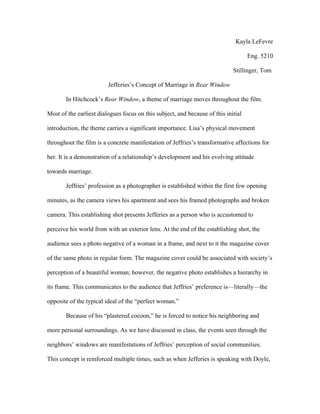
Hitchcock Rear Window
- 1. Kayla LeFevre Eng. 5210 Stillinger, Tom Jefferies’s Concept of Marriage in Rear Window In Hitchcock’s Rear Window, a theme of marriage moves throughout the film. Most of the earliest dialogues focus on this subject, and because of this initial introduction, the theme carries a significant importance. Lisa’s physical movement throughout the film is a concrete manifestation of Jeffries’s transformative affections for her. It is a demonstration of a relationship’s development and his evolving attitude towards marriage. Jeffries’ profession as a photographer is established within the first few opening minutes, as the camera views his apartment and sees his framed photographs and broken camera. This establishing shot presents Jefferies as a person who is accustomed to perceive his world from with an exterior lens. At the end of the establishing shot, the audience sees a photo negative of a woman in a frame, and next to it the magazine cover of the same photo in regular form. The magazine cover could be associated with society’s perception of a beautiful woman; however, the negative photo establishes a hierarchy in its frame. This communicates to the audience that Jeffries’ preference is—literally—the opposite of the typical ideal of the “perfect woman.” Because of his “plastered cocoon,” he is forced to notice his neighboring and more personal surroundings. As we have discussed in class, the events seen through the neighbors’ windows are manifestations of Jeffries’ perception of social communities. This concept is reinforced multiple times, such as when Jefferies is speaking with Doyle,
- 2. fantasizing about getting married and “rushing home to a hot apartment to listen to the automatic laundry and electric dishwasher and the garbage disposal and the nagging wife” (6:23-6:35). This description reveals his belief that marriage is simply a long list of unnecessary accessories that fulfill nagging chores. As he is saying this, the camera is looking to Mr. Thorwald’s window as he reenacts Jefferies’s descriptions. This pairing of dialogue and visual components establishes Mr. Thorwald’s window as the embodiment of the standard model of marriage. And, if the neighbors are metaphors for roles in society, than Jefferies’s position in his apartment is his own internal dialogue and thoughts. Jefferies’s dialogue with his physical therapist, Stella, extends his position about marriage. In the dialogue, Jefferies expresses his discontentment for Lisa: “She’s too perfect. She’s too talented, she’s too beautiful, she’s too sophisticated” (11:47-11:51). Lisa Carol Fremont is, “from top to bottom,” (16:44) the idealized woman like the magazines, and “she’s too everything but what I want” (11:51-11:53). This is where the framed negative picture is a tangible representation of Jefferies’s preference to the opposite of th popular concept of “perfect.” He states that he wants “a woman who is willing to go anywhere and do anything,” (12:31-12:36) and she accepts this challenge when she states: “If there’s one thing I know, it’s how to wear the proper clothes” (28:42- 28:46). Clothing, in this sense, could be read as her ability to adapt to his desires, to “play the part,” if you will. This can even be seen with her wardrobe: it starts with a very formal, elegant dress when she is positioned as the “perfect woman”; throughout the film, each outfit becomes more and more casual and informal, until her outfit consists of a simple, plain collared shirt and slacks.
- 3. Lisa’s position in Jeff’s mind also changes, like her outfits. In the beginning of the film, Jeff expresses his disbelief that Lisa could see the world in the same manner as him. Although he is speaking as to whether or not she could handle travailing with him, this seems to also apply to whether or not she can internally perceive the outside world the same as him. When he first speculates Mr. Thorwald’s guilt, she is skeptical and unbelieving. However, it seems that when she begins to believe Jefferies’s theory, her time spent at the apartment becomes more welcomed and less of a nuisance to Jefferies. It has already been established that Mr. Thorwald’s apartment is an embodiment of what Jeffries perceive marriage to be: the husband working long hours, only to return to a wife who is ungrateful and does not accomplish anything of her own, almost having no existence until her spouse returns home. Therefore, if Jefferies’s apartment embodies his thoughts and mental perception, than the metaphor of her agreement of his view of marriage is also a metaphor of of her agreement with his worldview. Agreeing with his perception is not enough for Jefferies to fully change his mind about Lisa. It is not until she moves outside the apartment, into the world in order to prove the flaws of the standard idea of marriage, that Jefferies reveals his fondness for her as he smiles when she returns. He begins to think in terms of “we” as Lisa had earlier in the film, and realizes this as he says “I guess I’m using that word ‘we’ a little freely” (1:32:30). The next time she enters Thorwald’s apartment to expose his failure as the standard husband, she puts Mrs. Thorwald’s wedding ring on her wedding finger and points it to Jefferies. This seems to be a manifestation of Jefferies now envisioning Lisa with a wedding ring after her demonstrations of embarking on adventure to break down the expectation of marriage.
- 4. Lisa has proven her ability to “go anywhere and do anything,” and because of this, Jefferies becomes more content. Her movement from the internal space to the external space is a representation of marriage moving from a thought to a more substantial reality for Jefferies. This may be overreaching a bit, but the theme of marriage is undeniably prevalent throughout the film. Therefore, I believe Lisa’s movement throughout the film is a physical manifestation of Jefferies’s character changing his standpoint on marriage.